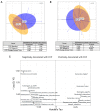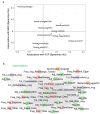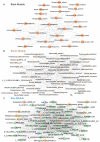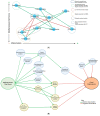Weighted Gene Co-Expression Network Analysis Identifies a Functional Guild and Metabolite Cluster Mediating the Relationship between Mucosal Inflammation and Adherence to the Mediterranean Diet in Ulcerative Colitis
- PMID: 37108484
- PMCID: PMC10138710
- DOI: 10.3390/ijms24087323
Weighted Gene Co-Expression Network Analysis Identifies a Functional Guild and Metabolite Cluster Mediating the Relationship between Mucosal Inflammation and Adherence to the Mediterranean Diet in Ulcerative Colitis
Abstract
Diet influences the pathogenesis and clinical course of inflammatory bowel disease (IBD). The Mediterranean diet (MD) is linked to reductions in inflammatory biomarkers and alterations in microbial taxa and metabolites associated with health. We aimed to identify features of the gut microbiome that mediate the relationship between the MD and fecal calprotectin (FCP) in ulcerative colitis (UC). Weighted gene co-expression network analysis (WGCNA) was used to identify modules of co-abundant microbial taxa and metabolites correlated with the MD and FCP. The features considered were gut microbial taxa, serum metabolites, dietary components, short-chain fatty acid and bile acid profiles in participants that experienced an increase (n = 13) or decrease in FCP (n = 16) over eight weeks. WGCNA revealed ten modules containing sixteen key features that acted as key mediators between the MD and FCP. Three taxa (Faecalibacterium prausnitzii, Dorea longicatena, Roseburia inulinivorans) and a cluster of four metabolites (benzyl alcohol, 3-hydroxyphenylacetate, 3-4-hydroxyphenylacetate and phenylacetate) demonstrated a strong mediating effect (ACME: -1.23, p = 0.004). This study identified a novel association between diet, inflammation and the gut microbiome, providing new insights into the underlying mechanisms of how a MD may influence IBD. See clinicaltrials.gov (NCT04474561).
Keywords: diet; inflammatory bowel disease; metabolomics; microbiome; ulcerative colitis; weighted gene co-expression analysis (WGCNA).
Conflict of interest statement
R.P.: Consultant, advisor, and speaker for Abbott, AbbVie, Alimentiv (formerly Robarts), Amgen, Arena Pharmaceuticals, AstraZeneca, Biogen, Boehringer Ingelheim, Bristol-Myers Squibb, Celgene, Celltrion, Cosmos Pharmaceuticals, Eisai, Elan, Eli Lilly, Ferring, Galapagos, Fresenius Kabi, Genentech, Gilead Sciences, Glaxo-Smith Kline, JAMP Bio, Janssen, Merck, Mylan, Novartis, Oppilan Pharma, Organon, Pandion Pharma, Pendopharm, Pfizer, Progenity, Protagonist Therapeutics, Roche, Sandoz, Satisfai Health, Shire, Sublimity Therapeutics, Takeda Pharmaceuticals, Theravance Biopharma, Trellus, Viatris, UCB. The remaining authors have no conflicts of interest to declare.
Figures








References
-
- Singh S., George J., Boland B.S., Casteele N.V., Sandborn W.J. Primary Non-Response to Tumor Necrosis Factor Antagonists is Associated with Inferior Response to Second-line Biologics in Patients with Inflammatory Bowel Diseases: A Systematic Review and Meta-analysis. J. Crohn’s Colitis. 2018;12:635–643. doi: 10.1093/ecco-jcc/jjy004. - DOI - PMC - PubMed
-
- Limketkai B.N., Godoy-Brewer G., Parian A.M., Noorian S., Krishna M., Shah N.D., White J., Mullin G.E. Dietary Interventions for the Treatment of Inflammatory Bowel Diseases: An Updated Systematic Review and Meta-analysis. Clin. Gastroenterol. Hepatol. 2023 doi: 10.1016/j.cgh.2022.11.026. - DOI - PubMed
MeSH terms
Substances
Associated data
LinkOut - more resources
Full Text Sources
Medical

